|
Vincent van Gogh
|
| Van Gogh at the 13year old |
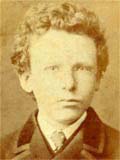
|
| 223 |
|
| Van Gogh at the age of 19 |
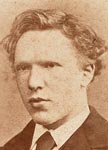
|
| 224 |
|
| Van Gogh, Self-Portrait with Straw Hat, 1887 |
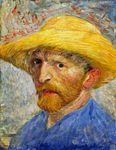
|
| 226 |
|
| Self-Portrait Dedicated to Paul Gauguin1888 |
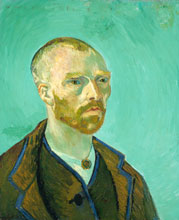
|
| 227 |
|
In order to understand more fully the complex mind of Vincent van Gogh, it is necessary to extend our study
to areas beyond his landscapes, and to analyze other areas of his life. Born in the Netherlands in March of 1853, one of six
children, he was always a loner and often unhappy, preferring to spend his time wandering outside by himself rather than playing
with siblings or friends. He developed an early fascination for nature, an interest that stayed with him and that emerged
often in his artwork, but he often found it hard to make friends. Throughout his life, this difficulty frequently resulted
in inordinate amounts of time spent alone, leaving him to focus his energies entirely on his painting. Until years later,
however, his artwork was no more successful commercially than its artist was socially. Van Gogh was often left alone and unhappy.
After a childhood where his only real friend was his younger brother Theo, Vincent attended a small boarding
school where he nursed a love for reading. Unfortunately, he seemed to be focused only on what he could teach himself, showing
no interest in the material presented to him in school. His grades suffered, and when he finally finished school, it took
him time to find his eventual profession. He joined the staff of the Goupil Gallery at the age of 16, but a few years later,
as Lilli Cristin tells us, “temperamentally unsuited to be a dealer and emotionally unstable, he was discharged”
(Cristen 2). This unpredictable temperament described by Cristin plagued van Gogh in his pursuits of the opposite sex (even
of his cousin), as he was twice rebuffed in his pleas for marriage.
Before finally managing to harness his emotions in his painting, Vincent looked to religion. Following his
desires to practice what became a lifelong religious fervor, Vincent entered missionary school, trying, and eventually failing,
to gain admission into the Dutch Reformed Church. He eventually developed an aversion to organized religion after these experiences,
but spiritual and religious themes later remained widespread in his paintings. It would take him three more years before he
truly embraced this calling in art, finding his place at the Royal Academy of Fine Arts in Brussels in 1880.
As well-known and liked as his paintings are today, they did not sell during his lifetime. By no means does
this mean that his artwork, or his life, should be considered a failure, but his numerous setbacks and disappointments are
worth highlighting. He weathered a difficult life, and we are left to wonder just how much his failures contributed to his
eventual suicide.
| Theo van Gogh |
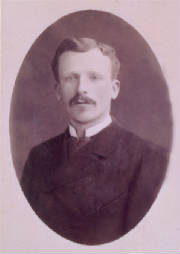
|
| 228 |
Best Friends
Though Vincent did not make friends particularly well, there was one bright spot. His relationship with his
brother Theo, four years his junior, proved to be a source of comfort and support throughout the years, and the friendship
between the two served as the one constant in Vincent’s rocky life. They were close from childhood, with Vincent taking
his younger brother with him on treks through nature, and Theo eventually developing as the go-between for Vincent and his
parents. The two kept their relationship strong, writing hundreds of letters to each other in their adulthood. Today, almost
all of what we know about Vincent’s life and his thoughts comes directly from these letters. Over 650 remain today,
giving us precious insight into the mind of a tortured artist, and illuminating the relationship between Vincent and his closest
friend.
However, in a turbulent life like Vincent’s, even his brightest relationship is not without controversy.
Theo was extremely important to his older brother, so does it not make sense that he may have contributed at least in part
to Vincent’s decision to commit suicide? We know that Theo was clearly in his brother’s thoughts, as Vincent repeatedly
asked for his younger brother in the hours after the fatal shot. Indeed, artist Marcel Marois, among other scholars, argues
that perhaps Theo was even too important to Vincent. “The first,” Marois claims, “in the series [of Vincent’s
fits of madness] coincided with the news of Theo’s engagement, the second with the announcement of his wife’s
pregnancy and the third with the birth of her child” (qtd. Cogniat 81). As his brother drifted further away and developed
more of a life of his own, Marois hints, perhaps Vincent struggled to cope with the perceived separation between the two.
As Raymond Cogniat writes in his book Van Gogh, “For several years Theo had been the only firm support on which he could
wholly rely. Suddenly he realized that he might be going to lose that too” (Cogniat 81). Such a perception would have
affected him deeply, and we cannot discount its importance in our exploration of the motives behind Vincent’s suicide.
|
